After my last article’s debacle, I was beside myself:
“You know what you need, Zonko? You need to go home and rethink your life.”
“I need to go home and rethink my life,” replied I, “but Zonko, we can’t write every article about losing Drafts. We want people to think we’re actually good at this game, remember?”
“Oh, right . . .”
“I mean it kinda sucks how so many of the really cool Drafts just lose to bad draws half the time. They aren’t bad decks, bad draws just happen.”
“Well, some of them are bad decks . . .”
“Ok, but they’re still fun and interesting!”
“That’s true.”
“And so many of the winning decks are just so dull. Really, who wants to read about another stupid GB Infect build?”
“I do!”
“You don’t count.”
“Oh . . .”
“I’m sorry, baby. I still love you. It’s just that I’m so frustrated! If only there were a way to Draft that would give us, I mean me, the freedom to explore cool decks without having to worry about things going all pear-shaped.”
“I like pears! They are so yummy with cheese.”
“You mean like cheddar?”
“Actually, I was thinking Swiss.”
The more we/I thought about it, the more Swiss Drafts made sense. It just so nicely solves the aforementioned issues of interesting vs. competitive, but there’s an even bigger problem that I have to deal with: I’ve only got so much time to spend on Magic. “The devil you say! Zonko, you can’t possibly be implying that you’ve got a life outside of virtual children’s card games?!” Not only am I implying it, O faithful yet impetuous and obnoxiously interrupting reader, I am stating it explicitly: I’ve got a life outside of virtual children’s card games. So there.
I like playing Magic. A lot. I play an absurd amount during the summer break, admittedly. However, on a given weekend during the regular semester, I might, might be able to squeeze two or three Drafts in. That’s assuming that it’s nowhere near a major exam. What this means is that for a given article, I have between four and six chances to produce something involving a) a technically instructive Draft, b) three rounds, and c) at least a few tactically challenging and/or entertaining scenarios. Unfortunately, those stars align only so often. I just hate being in the position of running Draft after Draft, and having to discard each one as “not good enough. “
Playing Swiss automatically eliminates any concern with “b.” No matter what happens, I will have three rounds to write about. This also largely solves “c,” since even losing rounds often yield interesting decisions. Finally, without having to worry about anything else, I give myself loads of freedom to do whatever the bleep I want to during the Draft — which, as my editors have so wonderfully acknowledged, is how I work best.
Draft
Deckbuilding
The first thing I like to establish, after building the bulk of the deck, is how many lands I’ll be playing. From there I can figure out what sort of liberties I can afford to take in splashing and other color commitments. This is informed by what is, in my opinion, the most important question in Limited deckbuilding: Does this deck want to play or draw? In this case, it isn’t much of a question; with our absurd card draw and formidable late game, we’ll be drawing every chance we get.
I realize that it may not be immediately obvious how drawing is better for a deck that wants to reach the late game. It goes something like this: any given game of Magic can, and should be, approached with the question of “Who is the beatdown?” Simply put, one side is usually more suited to attacking than the other. If the less-suited side chooses to attack, it won’t be able to defend in many circumstances, thus losing the game to the stronger opposing force. If the attacking side, or “beatdown,” neglects to push the advantage, the defending player will be able to “control” the board sufficiently to negate the beatdown player’s resources, which usually take the form of creatures. To put it in basketball terms, offense can’t afford to pass the ball willy-nilly while the shot clock runs, and defense, when they eventually get possession, probably shouldn’t turn around and take half court shots every time. The roles of defense and offense are dictated mostly by which side of the court the ball happens to be on. Playing first just means the ball starts on your side, which is only useful if you want to take advantage of attacking first (or, in some cases, if you need to deprive your opponent of attacking first); likewise, drawing first grants a player an extra boost in resources with which to control the board, sort of like a sixth man. Since our late game is almost certainly better than anything our opponents can put up, drawing is in our best interest.
Anyway, back to lands. Since we’ll be drawing better than half the time (most players tend to choose to play in Draft), seventeen lands should be fine, as we’ll have another draw to hit that precious sixth man. Land. I mean land. We’ll need about ten Islands to feel comfortable about being able to cast cards like Zenith and Corrupted Conscious as soon as possible, which leaves us seven to play with. In order to splash our Shatter and Artillerize, we’ll probably want to have two Mountains, as both cards are fine for the late game. Five Plains simply won’t be enough to reliably cast Kembas Skyguard anywhere near Turn 3, but I don’t think the flyer is really needed. I never liked him, anyway.
The other white card getting the boot is Myrsmith. I surprised myself with this one. With all of six artifacts in our deck, even cheap ones, the ‘Smith isn’t exactly at its usual near-bomb status. Though it’d be far from useless, serving at the very least as a removal magnet, it just doesn’t do very much for our deck. We don’t have any metalcraft for it to enable, and the only cards we might cut for it would be artifacts anyway.
Mindslaver is not very good against most decks. Excepting a board full of sacrifice outlets that won’t be sacrificed to themselves anyway, as soon as the ‘Slaver is played, the best you can really hope for is to force your opponent to use his removal less then optimally, then maybe shmush part of his team against part of yours. More than half the time, though, it’s a 10cc Time Walk + Geths Verdict that your opponent can usually see coming. Treasure Mage certainly makes it better, but still not good enough.
Speaking of Treasure Mage . . . aside from Mindslaver, the only other available target is Thundering Tanadon, a card that not only fits much better in an aggressive deck, but comes with a hefty life hit as well. As mentioned, the combination of Turn 3 2/2, Turn 4 5/4 will stop most Infect beats, especially when the life loss is a non-issue; aside from that, however, I don’t really care for it. Also, having only a single target for cards like Treasure Mage means that the tutoring ability is dead whenever you naturally draw the other card. There’s a good chance that it’ll just be a Grey Ogre, and that just isn’t very good.
Games
R1G1 we’re put on the play
Yeah, it’s got low drops and a Mind Control. We’ll be able to establish an early board presence, control it with Steel Sabotage, and eventually steal whatever we can’t otherwise deal with. Then we’ll make him deal with it. ![]()
We draw quite well, but now we’ve got a decision:
How are we going to play out? Which two-drop should we play first? Well, let’s evaluate our hand. Aside from the pertinent artifacts, we’ve got the two of the most powerful uncommons in the block to play with. Now, Spellskite makes a great bodyguard, not in the least because you practically need a Caster shell to do the job. If we can land it and the Anatomist at the same time, our opponent will need two Caster shells to not lose. We may as well make that three by bouncing the ‘Skite on his first try, which means that we’ll need to have an Island untapped for the first turn after we play it. After that, we can play the Vedalken, controlling the board until our Adversary plays something worth stealing. But for now we’ll be playing something that doesn’t mind dying, and I would not be surprised if Myr Sire keeps a toaster where his soap should be. Gust Skimmer is a more offensive option, but we’d rather play to our absurd controlling strengths, and save the sometime flyer for when we can afford it.
I actually botched this line slightly by playing Turn 2 Myr Sire, Turn 3 Anatomist, but as our opponent’s second color was a single Plains to complement his Ezuri-themed deck, we weren’t made to suffer for it.
We draw into a few more flyers, slowly ending his life. At one point, I made the mistake of ‘Skiting a Mutagenic Growth played in response to Anatomizing at end of his turn. While it didn’t cost me anything in terms of card advantage or board state, it did lose me an admittedly insignificant 2 life but more importantly presented a tell on our counter. [This was a good pair of paragraphs][you think so?]
Oh yeah, and he had a Vorinclex. Apparently.
It’s worth noting that in the course of the game we drew both our Artillerize and a Mountain, but played neither of them nor the Mind Control. When you can afford to do so, play as close to the vest as possible. For most of the game, we were in control of the board state to such a degree that only a combination of rares and mythics could swing things for him, and half of those are covered by Steel Sabotage. There was simply no reason to play Corrupted Conscience, not even for Vorinclex, who was most certainly not named after his/its (vat)mother’s current pain medication. It’s possible, though unlikely that he knows to play around the Aura; without our playing the Mountain, however, he won’t be able to see the burn coming if and when it matters.
Sideboard: we’re not concerned about stopping any beats, so the Treasure/Tanadon duo get shunned for the unnatural pairing they represent.
R1G2 we’re put on the draw
A day may come when the courage of Men fails, when we forsake our friends and choose to keep a one-land hand, but it is not this day! This day we mulligan!
This one’s fine. We’d like to draw more spells than land, but Myr Sire will hold the ground long enough for his friends to show up. I mean, if he had friends.
Due to an unfortunate glitch on our opponent’s end, we win off the clock, but very likely had the game anyway.
Interestingly enough, we managed to play this entire match without revealing either Corrupted Conscious or the fact that we’re playing Mountains.
R2G1 we’re put on the draw (people don’t learn, do they?)
A solid, if unexciting hand — which, by the by, speaks volumes of the general quality of our deck. The only strategic point to be made is that Perilous Myr should never be played against an open board and a full hand. There’s no reason to give your opponent a chance to remove it without any consequence above a slap to the face. Myr Sire is almost as good defensively, and is much less vulnerable to removal.
The game progresses and our early aggression stalls on a few sorely-missed lands. After a fairly explosive start, Mindculling into Zenith would have been just about it, but we instead miss drops 5 and 6 and are punished for it.
Here’s a teaching moment for y’all: never concede before you’ve lost. Without any plays, I left all five lands untapped, just waiting for my opponent to attack and kill me with exactly enough damage, after sacrificing. But that didn’t happen. He must have been scared of bounce spells, or maybe he just forgot, and he didn’t go for it. Considering the amount of tricks I could have in my colors, I can’t say he was absolutely wrong, as I’d still be dead on the following turn to his Imp.
Did I say his Imp? MY BAD.
To make this sweeter than it had any right to be, he didn’t sacrifice his Imp in response. I’d effectively neutered my opponent and somehow engaged in a depraved experimental surgery on myself. We win in short order with regular evasive damage while he focuses Trigon on Flesheater.
On a side note, Trigon of Corruption is laughably bad against Spellskite.
SB our Treasure Mage play gets better against Infect. We board that in, exchanging some artifact hate, which seems to be less effective against him.
R2G2 we’re put on the play
We’re sadly short on Plains, but will soon have a very, very resilient Tanadon. As with the first game of Round 1, we’re better served preserving the Spellskite, even though it’s not actually tougher to kill than the 5/4, just because we can expect an immediate attempt on its life and would rather not have to keep mana up the entire game. There is the question of balancing the combat aspect of Blessing with the ‘Skite’s efficiency, but I prefer the later. Spellskite also protects other creatures indefinitely, whereas Blessing is obviously transient. As such, it’s probably correct to wait until Turn 3 to cast the 0/4.
Do we play out the Tanadon now, or wait for some more protection? This is actually a rather general question: is it correct to play an important threat when your opponent may have removal? The ‘may’ is key there, especially with Spellskite as emergency backup. Playing the Tanadon immediately places us in the driver’s seat, and puts the guy across the table into a situation where he needs to have at least two good removal spells in hand to not lose, and a third if he lets us untap.
Well, he had two, that’s for sure. Even though we’re on the back foot, the fact that we’ve got so much power on the board and in hand means things can turn around very quickly. And, after our opponent declines to block our 5/4 with his 2/2 for the second time, that’s exactly what happens. Can you see it?
Okay, so it’s a little misleading that Suture Priest hasn’t triggered yet, but I assure you it does happen, putting him to 8. On our turn, we simply attack with both our creatures. He blocks our 5/4 with his 3/3, taking 3 total damage, exactly enough for Artillerize to finish him off. GG!
R3G1 we’re put on the play
In retrospect, this was a terrible hand. It’s the sort of seven that would be fine, even great, on the draw if they can’t deal with VA, but missing that extra card just wrecks it.
What’s the play here? Do we play reactively, protecting Spellskite while controlling whatever threats appear, or do we proactively cast a flyer? I chose the latter, and immediately regretted the decision as he immediately destroyed my Spellskite. Though the Anatomist ended up surviving the entire game, having a 0/4 on the board would have saved me at least six points of very relevant damage. We lose to an overwhelming stampede of beats.
R3G2 choose to draw
Compare this hand to last game’s. Even though both hands contain cards that won’t get played until much later, this one actually functions on its own two lands. Between Perilous Myr and Steel Sabotage, this seven provides enough early disruption for the Anatomist to come down and immediately control the board. Without the Myr, we might be put in a position where we’d be forced to use all our mana every turn while getting overrun, which is basically the only way to beat Anatomist outside of red, black, and a handful of enchantments. If we survive long enough to hit a seventh land, we’ll ride Blue Sun’s Zenith all the way home.
Should we block here? Honestly, this isn’t very much of a decision. If Perilous Myr can trade with it, it can go ‘splodey later. We aren’t so concerned about taking 2 to 4 damage over the next few turns from something that (quickly) dies to Anatomist.
Painsmith bites the dust the turn before our dear Igor does, and the board remains in our slight advantage as we play some flyers. He plays a Marauder, which would be more upset about if it didn’t leave him with two cards in hand for our Mindculling.
We develop our board a little to try and bait removal before Corrupted Consciousing (which, I imagine, is a bit like dirty guilt-tripping) his Marauder. It takes a few turns to eat through his consistently-drawn blockers and chunky life total, but our ridiculous card advantage gets there.
SB since our opponent put us on the play in Game 1, we know he’ll choose to do so again. We’ll add another land to lower the chances of needing to mulligan. If you recall, our decision to play seventeen was partially justified by the assumption of our drawing first. Though that has largely been the case, we need to adjust accordingly when appropriate, and not in polite company.
R3G3 on the play (called it!)
I do not like this hand. I do not like it in a house; I do not like it with a mouse. It’s like the bastard child of our previous two draws and looks like someone peed in its gene pool. However, it does have some redeeming qualities. Judging from the first games, Steel Sabotage should be very relevant, and Wayfarer, while by no means as threatening as Igor, is quite a bit more durable. By the time our opponent casts something that can eat the elephant, we should be in a better position; until then he can soak up damage. Also, since he’s playing green, he probably won’t want to stop at five or six lands, so the angel will likely net some value if it shows up late. It’s a risky keep, but I feel safer about it than the idea of a random six on the play.
What happens next is the very definition of Epic Windom. You know what? This article is damn near long enough. I’m going to show the pictures, and y’all can figure it out for yourselves.
Hail to the king.
Oh, and here’s a bonus Draft!
And the decklist:

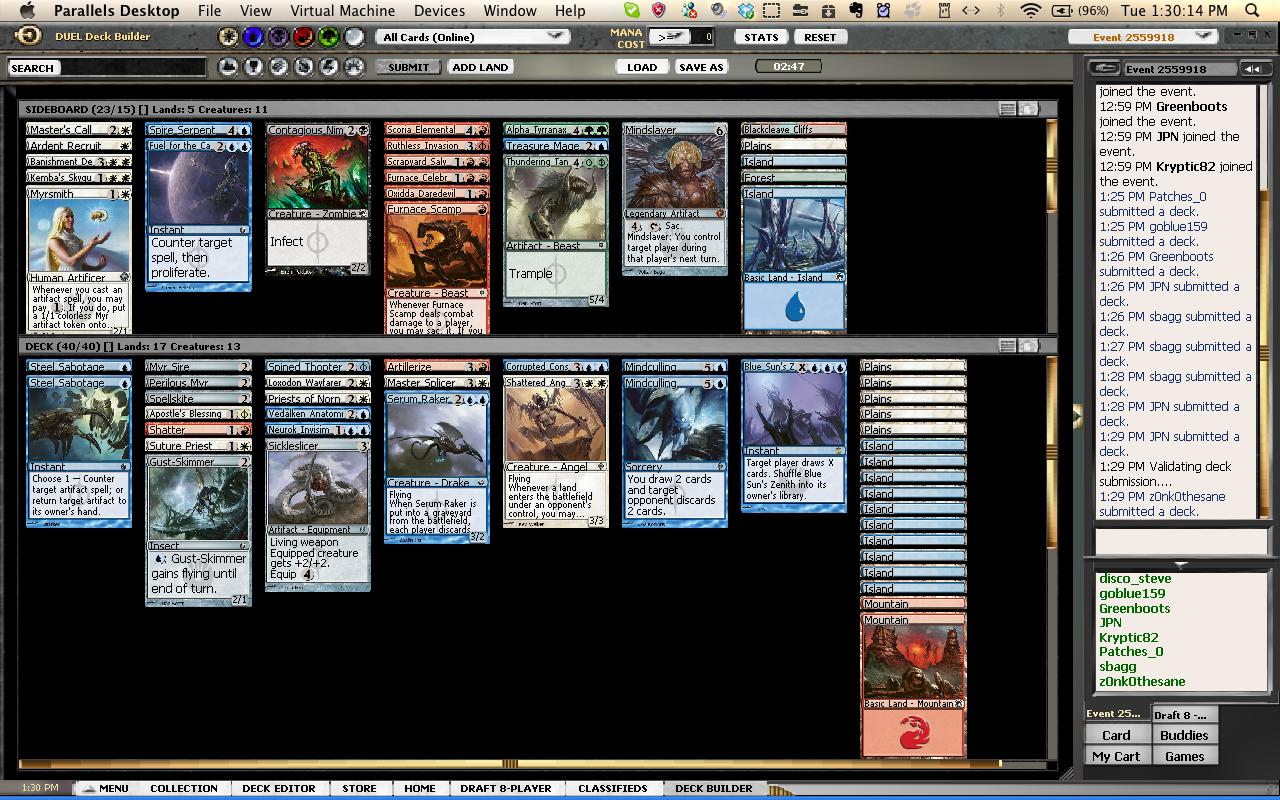

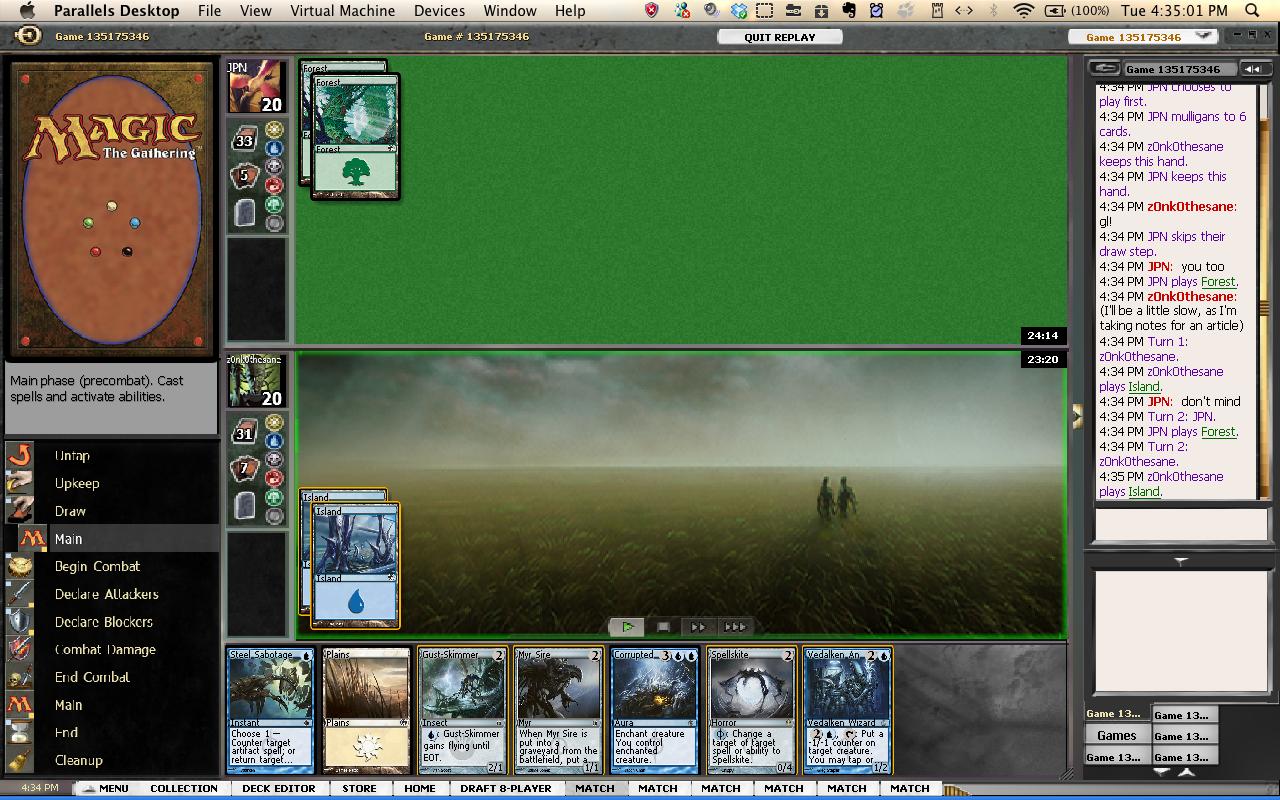



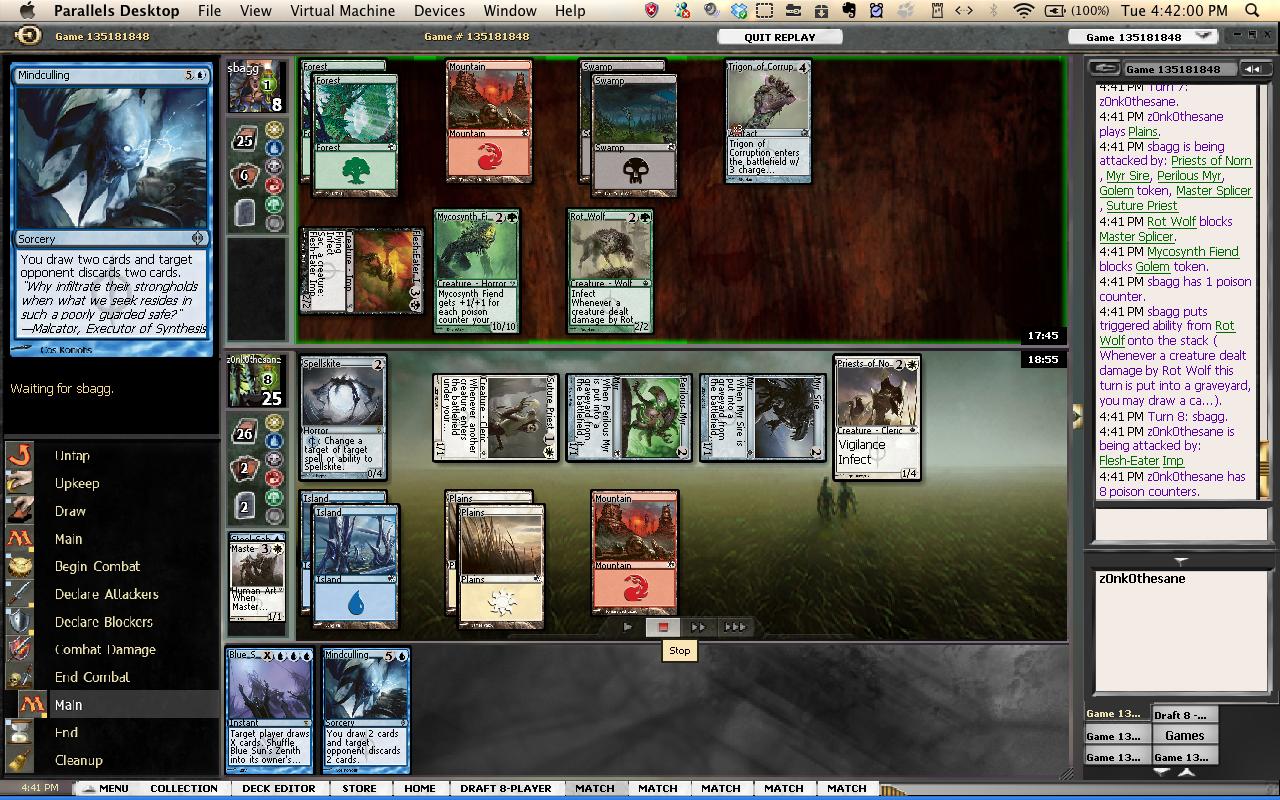
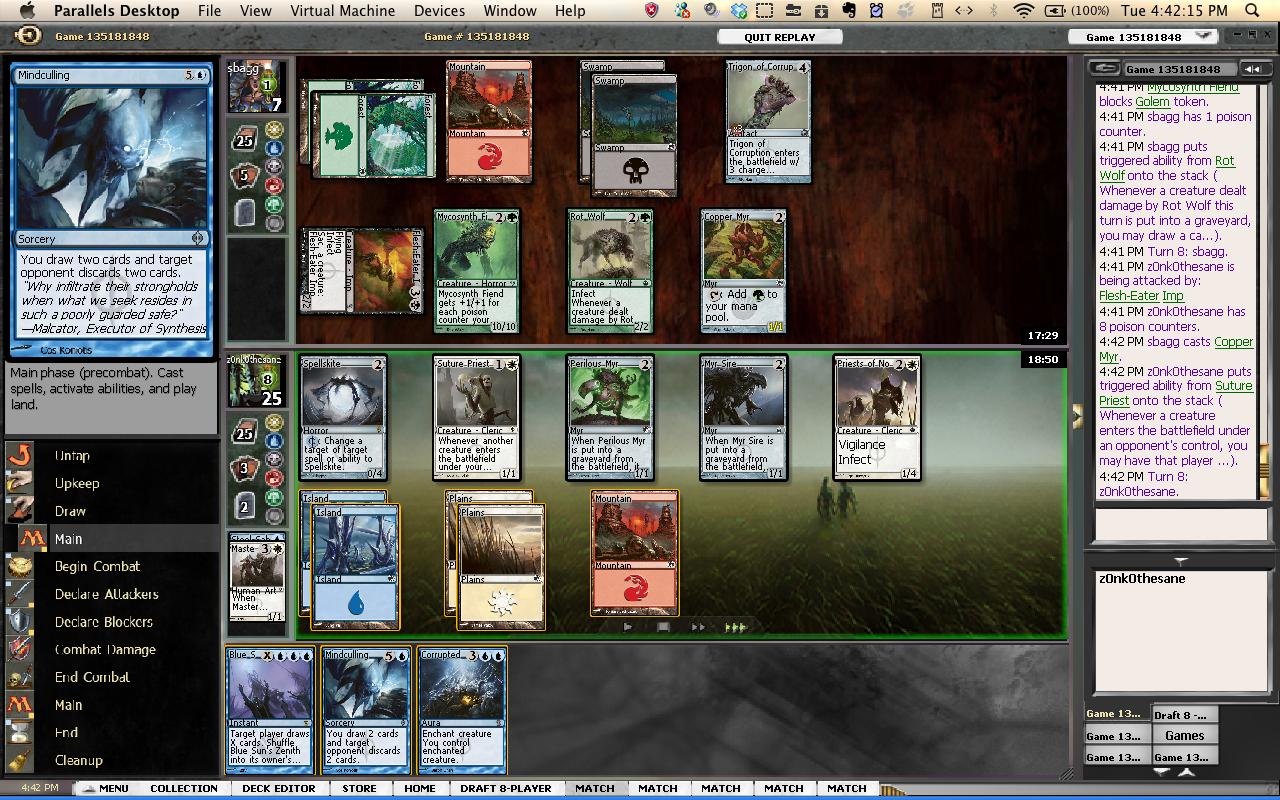

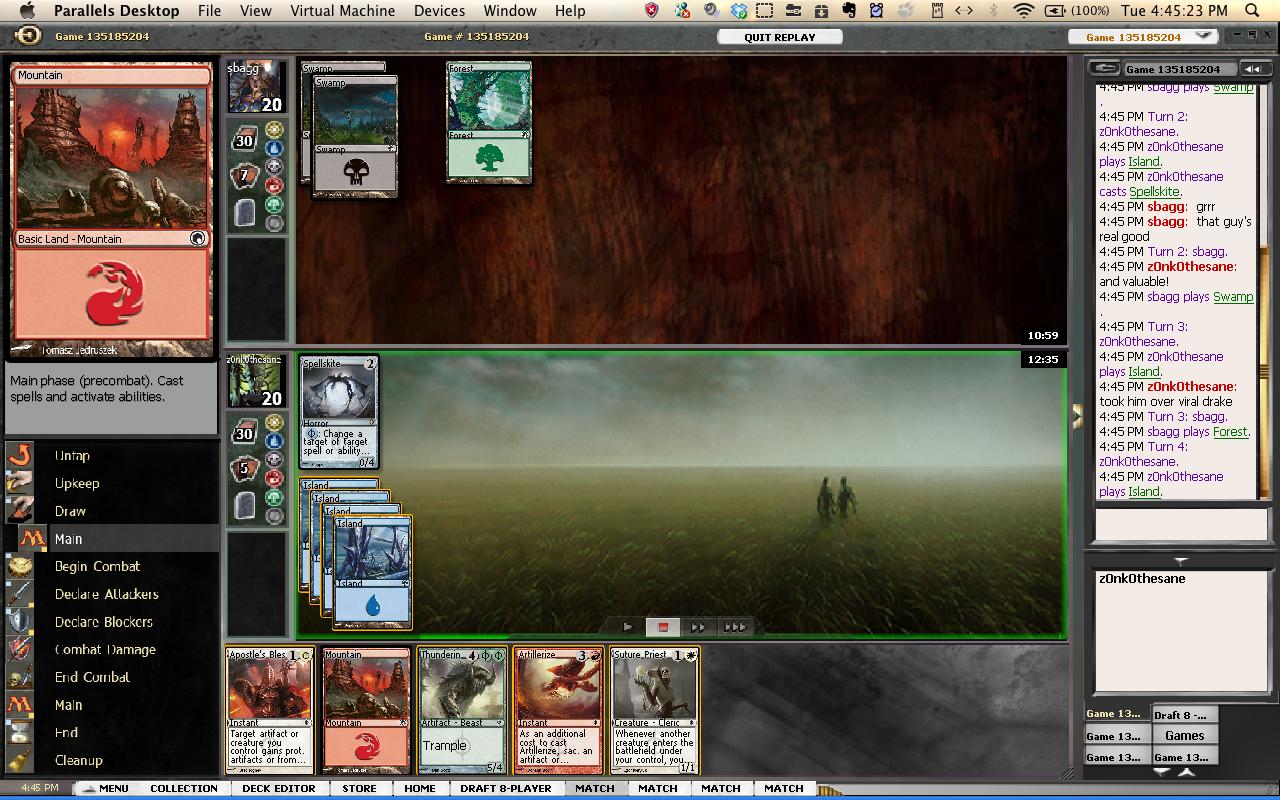
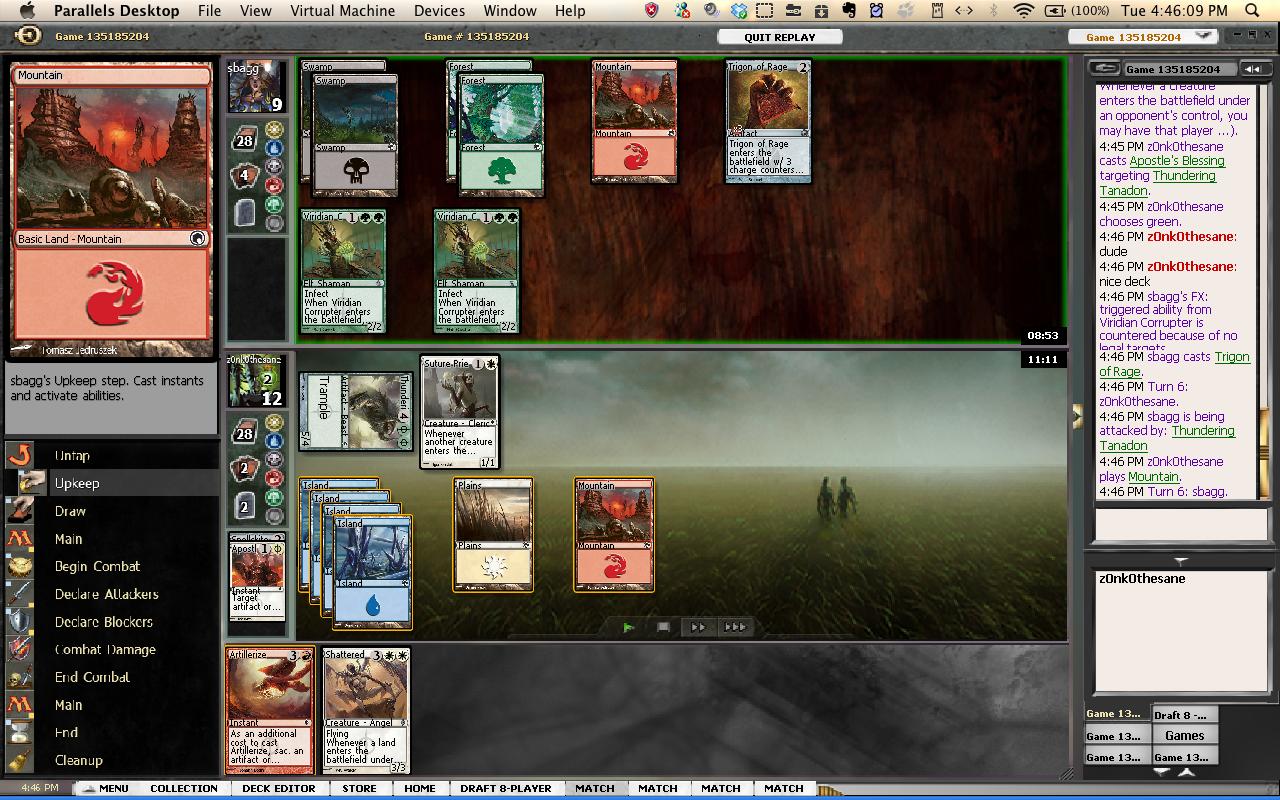
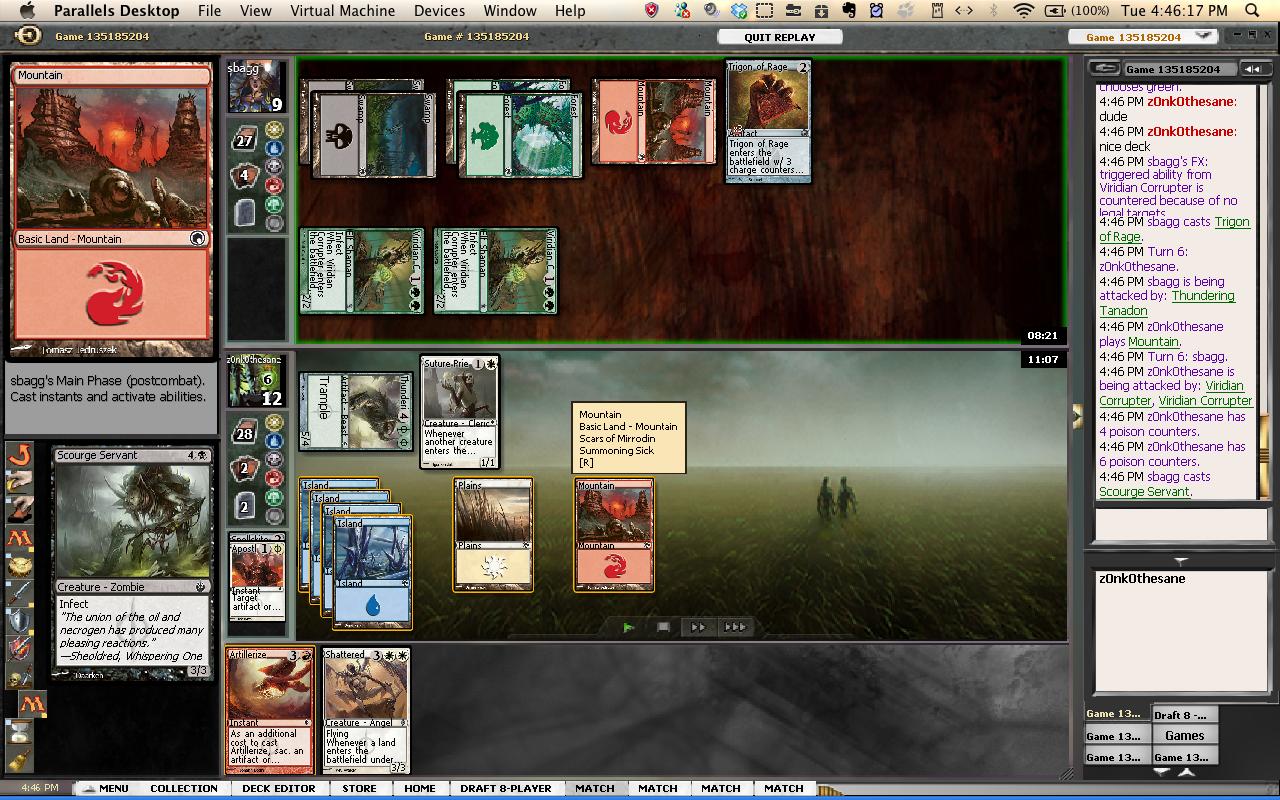

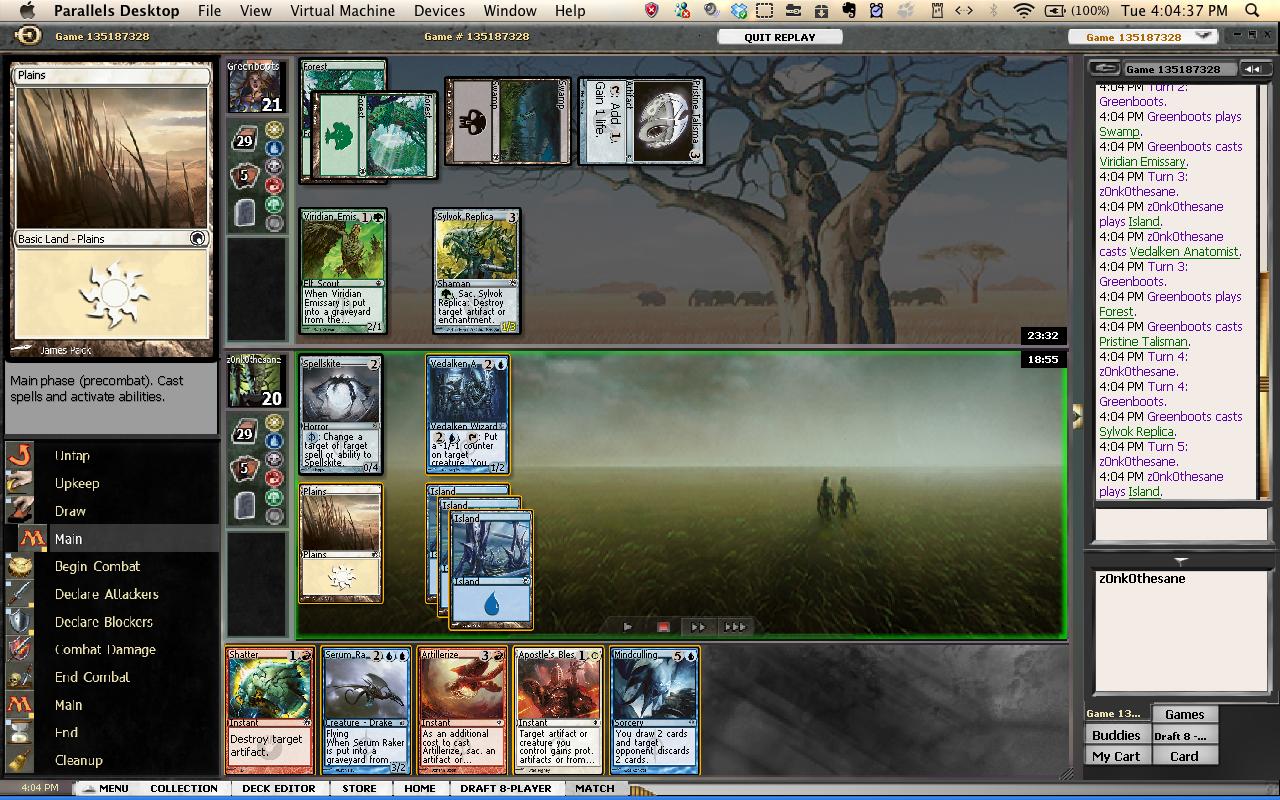

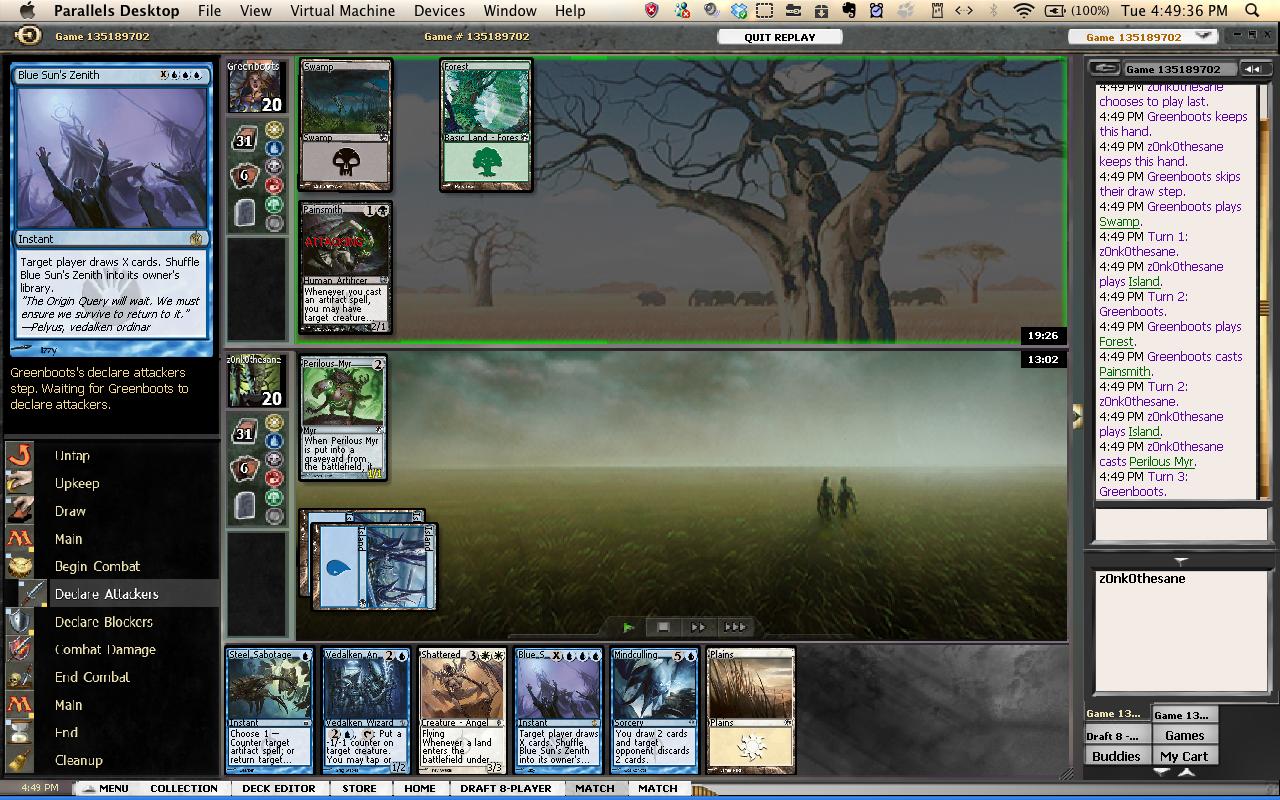


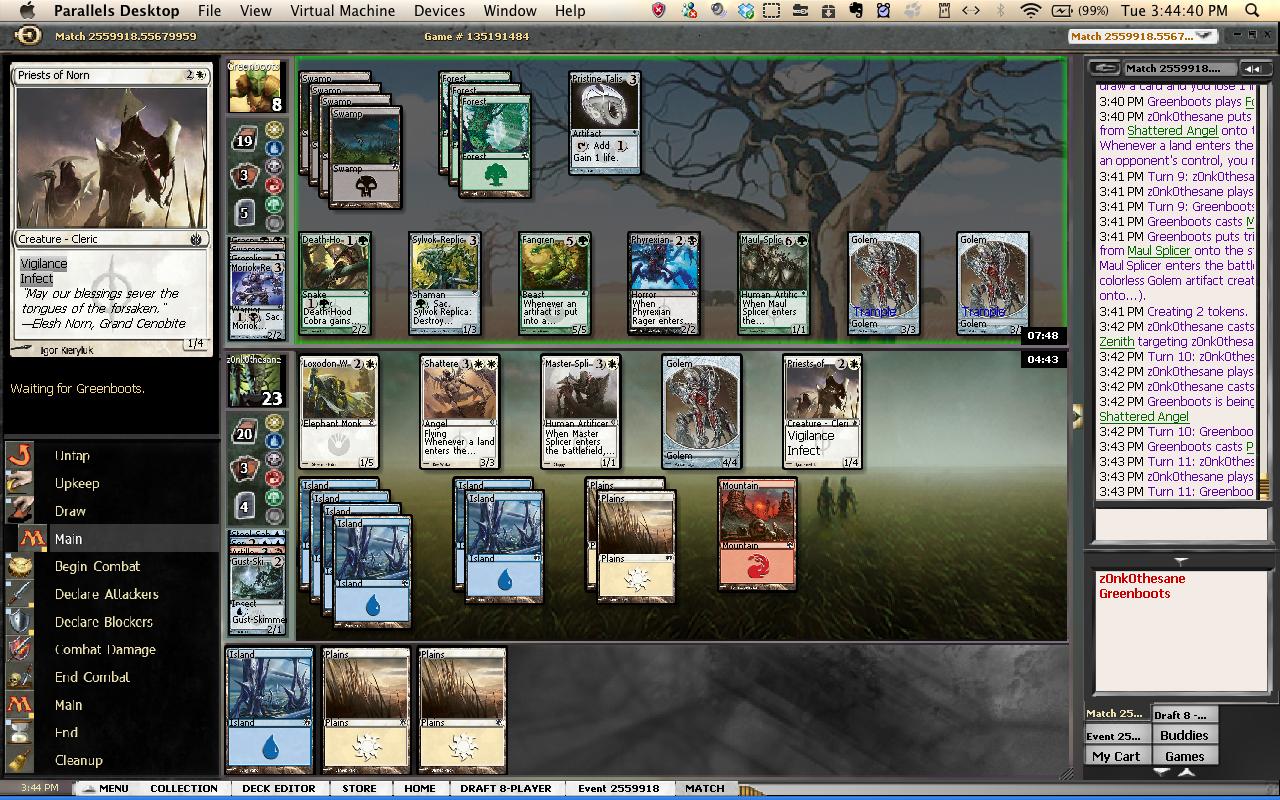
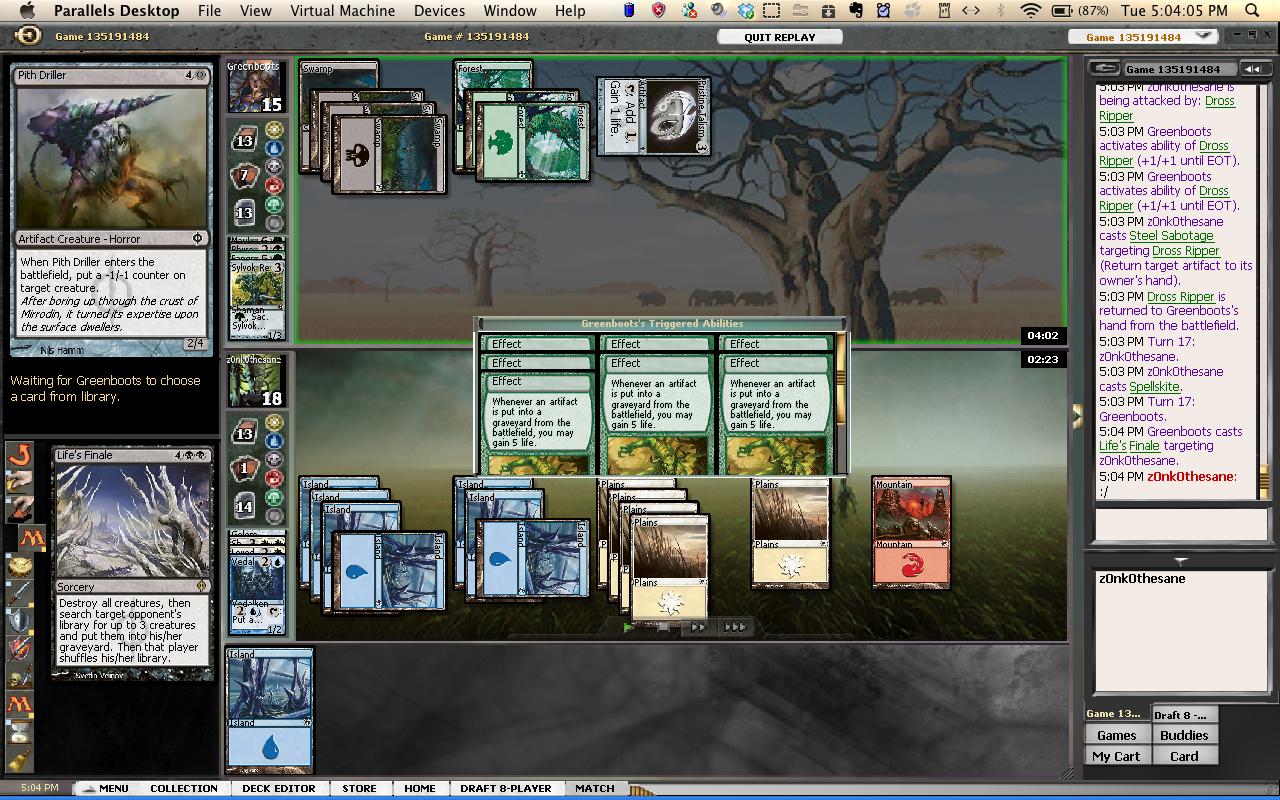
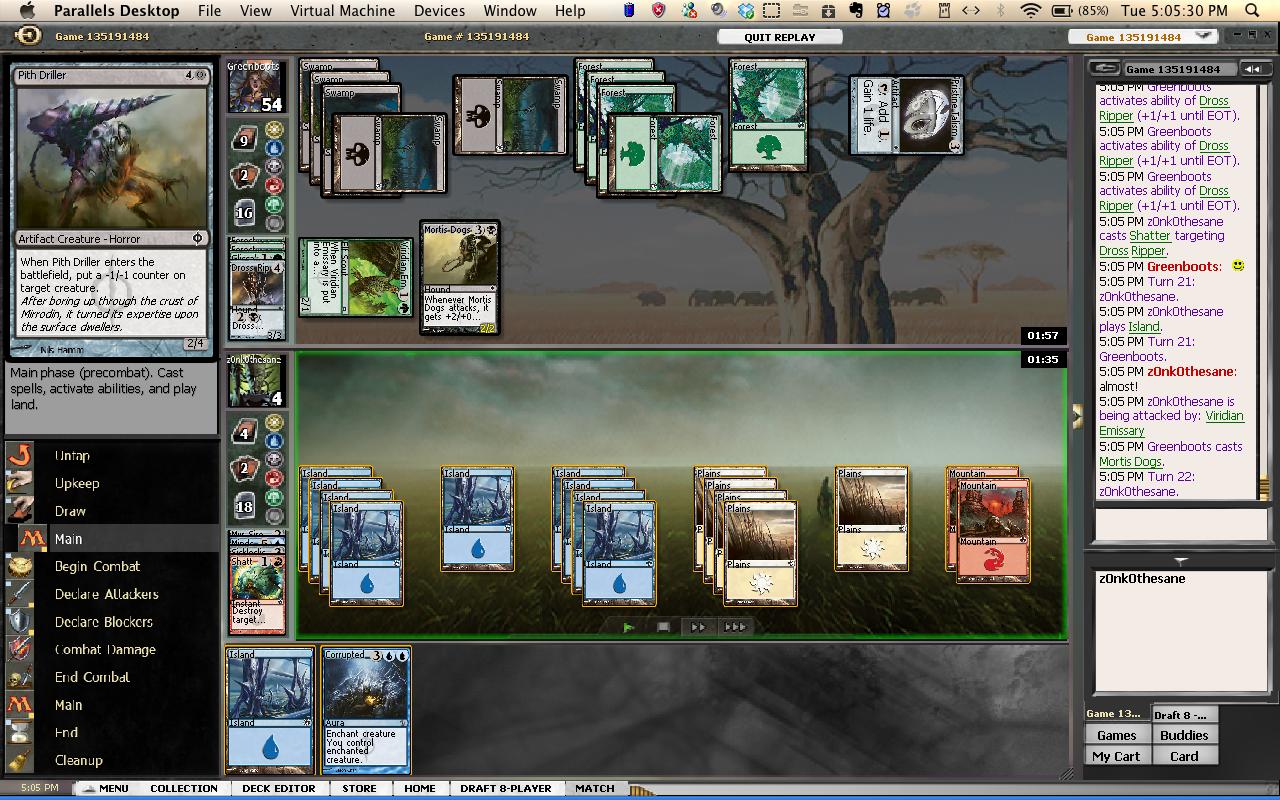
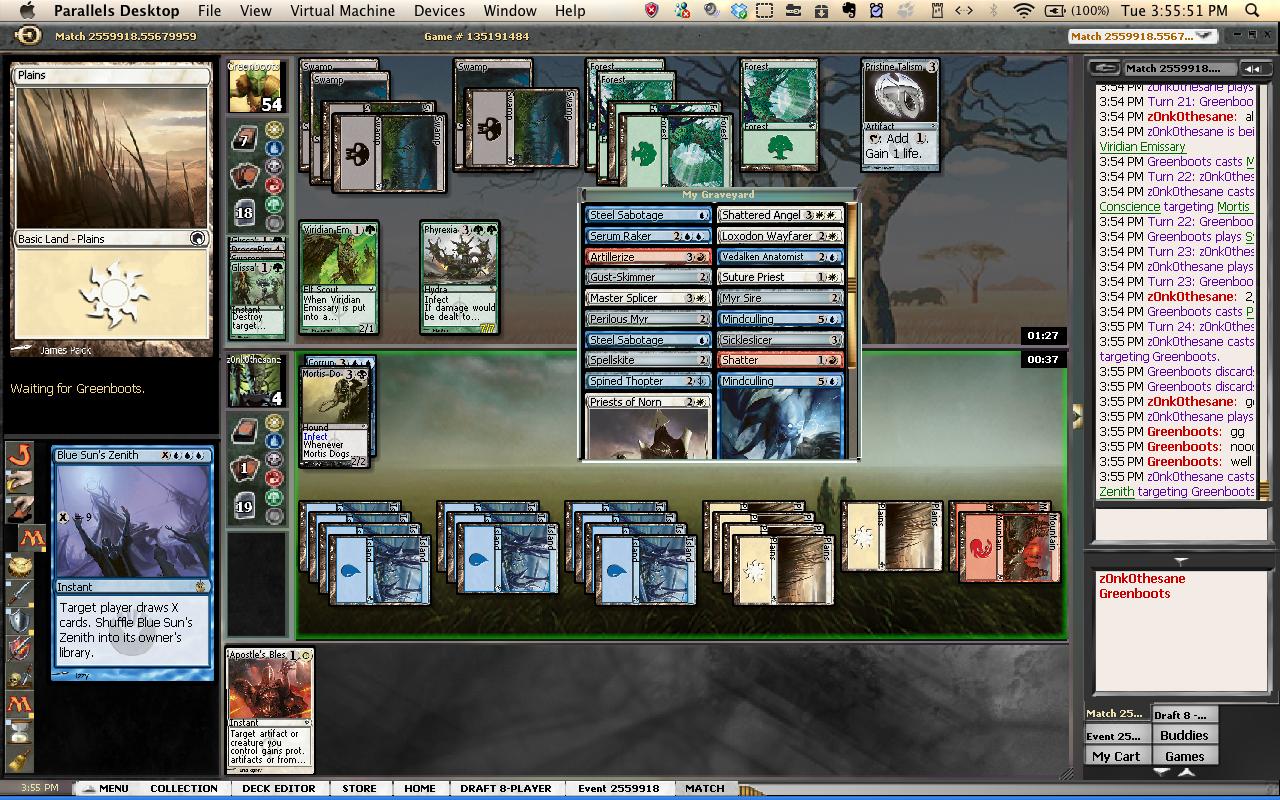

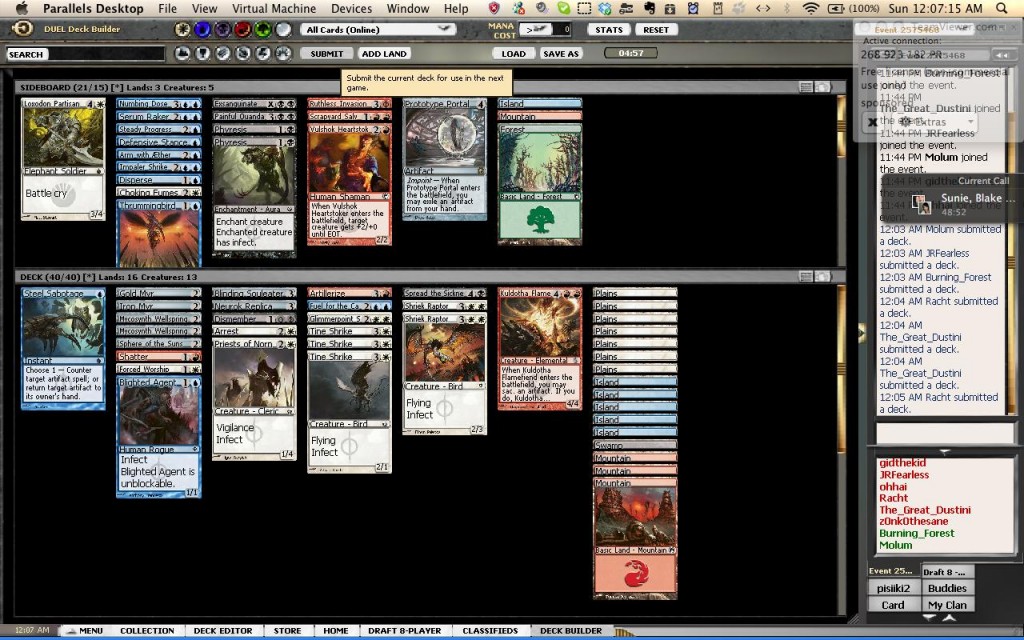
I love BSZ kills. After something dumb like this happens, it’s even more satisfying. :thumbup:
Nice draft. Love me some BSZ. I find myself going 3 colors a lot this days. Invasion is my favorite draft format ever, so 3 colors is really “toned down” for me.
And please tell me you lived the dream and went 4 color in the bonus draft! How did it go?
I went 4 color infect in a triple NPH draft and went 3-0. Multiple Wellsprings, Viral Drake, Artillerize, etc. Not that those drafts have the highest skill level, but they’re probably on par with the Swiss drafts
Some crazy boosters here. 6th pick Vedalken Anatomist is crazy on its own, but if it has a Strandwalker and a Divine Offering, that is more than crazy. The 11th (or later) pick Trigon of Infestation should make someone happy too.
I’m not sure you need the Zenith in addition to the 2 Mindcullings. Doesn’t seem that you managed to use it.
@ CH:
@ Gixor: As the format slowed down, I’ve been favoring control builds more and more. This, of course, makes splashing the odd Artillerize that much easier. Though I prefer UWr, black and red have a surprisingly large pool of card advantage generators, and love to splash a Remember the Fallen. And yes, I did go large on the bonus; unfortunately, it only went two rounds, but I’ll post the decklist soon. I love triple third-set drafts, Mono-Red in Eventide particularly. Oh, and Rise =p.
@ milegy: Not sure if trolling . . . >_>
Hello
It is really amazing. Congress for your nice post. Please post more articles.